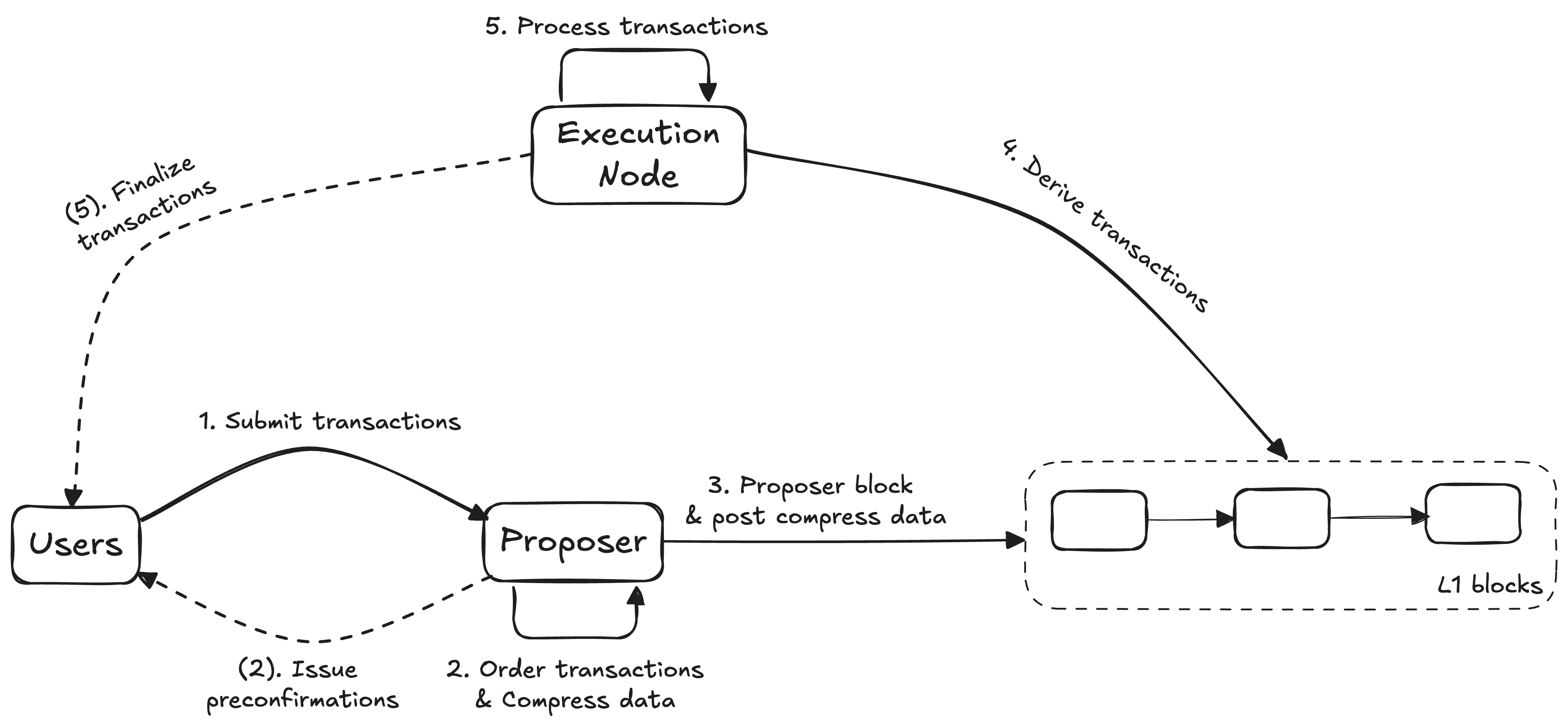Based Rollups
Motivations
At the core of a rollup is the sequencer - a critical entity that manages the transaction flow on the rollup, ensuring efficient and secure interaction with the L1.

 A general paradigm of a rollup.
A general paradigm of a rollup.
The sequencer fetches and orders incoming transactions from the mempool into blocks (similar to block proposers in regular blockchains). It also creates L2 checkpoints by posting the latest state commitment to L1. It acts as an intermediary between the L2 and L1, performing the following functions.
- Ordering. The sequencer receives transactions from users on the L2, orders them, and includes them in blocks.
- Execution. The sequencer executes the transactions and updates the state of the rollup.
- Batching. The sequencer groups transactions into batches, compresses the data, and submits these batches to Ethereum.
- Preconfirmation. The sequencer advertises an RPC endpoint for users to submit transactions to. As a response, the sequencer issues soft confirmations on user transactions.
Why Centralized Sequencer?
Traditional rollups favor centralized sequencers because they offer several advantages, such as:
- High performance. Centralized sequencers are very good for performance. They can handle a high volume of transactions efficiently because they usually operate on high-end machines, allowing rollup networks to scale and accommodate a growing user base.
- Low latency. These sequencers typically operate on high-end machines with minimal delays, providing users with a faster and more responsive experience. This low latency is crucial for applications that require quick transaction confirmations, such as decentralized exchanges or lending platforms.
- Simplicity. Setting up centralized sequencers is relatively straightforward as no consensus is required. This reduces operational overhead and simplifies transaction processing.
Censorship Risks
Despite the benefits, a centralized sequencer can become a single point of failure, making the entire rollup vulnerable to technical failures, attacks, or manipulations. If the sequencer encounters issues, such as bugs or network outages, it can halt transaction processing entirely, leading to delays and service interruptions.
Besides, a centralized sequencer has the power to censor transactions at will: he can selectively exclude or reorder transactions based on their preferences or business interests. This raises concerns about censorship resistance. If he refuses to process certain types of transactions, perhaps due to regulatory pressure or self-interest, users may find themselves unable to execute essential operations within the ecosystem. The impact of censorship undermines the fundamental principles of a permissionless network.
Based Sequencing: Leveraging L1 for Censorship Resistance
Based sequencing is the mechanism that allows a subset of L1 proposers to take the sequencing role in a rollup. Instead of an L2-specific sequencer, the L1 proposers - the same entities responsible for building Ethereum blocks - get to decide which L2 transactions get included and in what order, typically by including L2 blocks or bundles within their L1 blocks.
The Workflow


Users submit transactions to the current L1 proposer. The L1 proposer then orders these transactions, similar to how he orders regular L1 transactions. After the ordering, the rollup's execution node will start processing these transaction off-chain, and generates a new state of the rollup.
The Advantages
Based sequencing is the decentralization strategy for RISE. With the based approach, we can offer:
- Decentralization. Based rollups inherit the decentralization of the L1 and naturally reuse L1 searcher-builder-proposer infrastructure.
- Liveness & Censorship resistance. When a rollup uses based sequencing, it automatically inherits L1's liveness and censorship resistance properties. Based sequencing relies on the decentralization and censorship resistance of the L1 and, thus, users can exit the rollup without extra costs or potential delays.
- L1 economic alignment. MEV originating from based rollups naturally flows to the base L1. These flows strengthen L1 economic security and, in the case of MEV burn, improve the economic scarcity of the L1 native token. This tight economic alignment with the L1 may help based rollups build legitimacy.
- Synchronous composability. Based rollups are sequenced by L1 validators, who might also sequence other rollups at the same time. Therefore, it is possible that users on RISE can talk to contracts on a different rollup in an atomic way, making synchronous composability possible.
Comparison with Centralized Rollups
| Feature | Based Rollups | Centralized Rollups |
|---|---|---|
| Sequencers | L1 Proposers | L2-specific entities (often single or small set) |
| Decentralization | High | Low |
| Censorship Resistance | High | Low, escape hatch required |
| Liveness | High | Low |
| Trust Assumptions | Low (L1 assumptions) | The sequencer is often trusted for liveness and censorship resistance |
| Composability | Potential for synchronous (atomic, same-block) interactions | Asynchronous (requires bridges, higher latency/complexity) |
| Preconfirmations | See Based Preconfirmations | Can be very fast, depending on the sequencer |